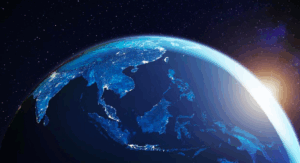The Pacific Islands Region comprises the island states and territories distributed over an area of 70 million km2 of ocean between East and Southeast Asia and the Americas. It is conventionally subdivided into the ethno-geographic ternion of Melanesia, Micronesia, and Polynesia. Pacific Island polities are very diverse in terms of territory, population, developmental and political dynamics, economic resilience and governance capabilities. Yet, Pacific Islanders are acutely aware that their countries and societies – their very land and ocean – are all vulnerable to the effects of climate change. Accordingly, in the 2018 Boe Declaration, the leaders of Pacific Island Forum nations conveyed that climate change is the “single greatest threat” to the security of their region and concurred on an expanded concept of security putting climate change center-stage, alongside traditional security issues.
The climate change risk arising in the Pacific Islands is taking diverse pernicious forms: rising ocean temperatures, shifting rainfall patterns, changing frequencies and intensities of storms and drought, rising sea levels, and changing ocean chemistry affect marine and terrestrial ecosystems, as well as local communities, livelihoods, and cultures. Climate change is impacting on human health, infrastructure, coastal resources, disaster management, fresh water availability, agriculture, fisheries, forestry, marine ecosystems and tourism.
Drawing from the available literature – as well as from the examination of the Pacific Islands’ socio-economic situation, regional policies and political discourse – it is possible to identify six climate-fragility risk clusters for the region: 1) climate displacement and migration; 2) impacts on ocean economy (fisheries, tourism); 3) impacts on health, food and water security; 4) natural disaster recurrence and coping capacity; 5) Impacts of sea-level rise on maritime zones and boundaries; 6) Penetration of transnational organized crime and terrorism.
1) Climate displacement and migration
The combined action of climate change, environmental degradation and natural disasters cause displacement and forced migration, both internally and transnationally. For Pacific Islanders, whose livelihoods and sustenance depend on delicate ecosystem equilibria, degrading environmental conditions have dire consequences. For example, the soil in coastal areas and low-lying atolls, even before being inundated, would become sterile due to salt water infiltration and erosion. Human habitation would then become unsustainable, and people would be forced to resettle or migrate within and between countries. Since land is a scarce commodity in the Pacific Islands, and is often customarily owned, the resettlements are likely to be resisted by local authorities and communities. This creates a risk of social tension and violence, especially if the resettlement is conducted without proper consultations with host communities. Apart from the unavailability of land for resettling, factors like ethnic and cultural differences between the migrating or receiving communities, or the strain the newcomers put on local resources and services can further complicate – or derail – the relocation process.
2) Impacts on ocean economy (fisheries, tourism)
The economies of many Pacific polities are heavily dependent on the revenues generated by fisheries and tourism, often referred to as the ‘ocean economy’. Climate change threatens to adversely affect both industries. Notably, the Western and Central Pacific Ocean contains more than half the global tuna stocks, on which several Pacific SIDS are critically dependent on. Global warming is undermining this important source of revenue and employment because, as temperatures increase, marine species such as tuna are gradually moving away to seek colder water. The climate-spurred eastward migration of tuna stocks is going to significantly diminish the catches of both industrial and small-scale tuna fisheries. According to the projections on regional tuna stocks redistribution, by 2050 the reduction of tuna biomass in the island states’ Exclusive Economic Zones could result in overall government revenue losses of up to 15 percent yearly for eight of them. The projected figures on tuna migration patterns – and the interrelated financial and occupational negativities – are causing great concern in the Pacific also because, on the one hand, they would unsettle the architecture of regional arrangements governing the tuna resources, and on the other hand lead to serious tension between the island nations and distant water-fishing states.
3) Impacts on health, food and water security
Climate impacts are increasingly undermining Pacific peoples’ health and quality of life, thereby impairing their ability to contribute productively to their economies and families. the In a region where healthcare systems are under enormous stress, the potential diminution of healthy, traditional and affordable food sources for local communities is particularly alarming. The aggravation of food and water security caused by climate change, combined with existing problems, would put at risk the livelihoods and health of Pacific Islanders, and bring about increased fragility with a potential for instability. Water security is another front of Pacific Island climate security. Many parts of Insular Pacific suffer from a lack of access to safe piped water and deficient water sanitation. In addition, climate change phenomena like inundation, salt water intrusion and droughts threaten fresh water supplies for low-lying atolls and small islands which recurrently declare states of emergency.
4) Natural disaster recurrence and coping capacity
The Pacific Islands are in one of the most natural disaster-prone regions in the world. Tropical cyclones are the most common form of natural calamity in Pacific Island countries, and the main cause of destruction and economic loss. Such cyclones can inflict hefty damage to infrastructure, such as roads, port facilities, power, commercial buildings and housing. Also, the agricultural sector can be hit tremendously hard, while reef fishing zones and forestry can be considerably impacted. Losses in other productive sectors, including manufacturing and tourism, can also be extensive. For small island countries with a high dependence on agriculture and limited sector diversification, the economic repercussions are especially traumatic.
Global warming is causing more frequent and fiercer cyclones and extreme weather. Their increasing recurrence, with shortening recovery periods in between, drives up the fragility risks and foils the island states’ development gains and potential in two ways. In the first place, damage to productive assets can result in serious loss of production and reduced economic growth. Secondly, climate change-instigated environmental hazards are augmenting the vulnerability of the Pacific Islands states while impairing their ability to invest in coping capacity. In fact, in response to post-disaster rehabilitation requirements, governments resort to a reallocation of budget expenditure and, in some cases, to cutting current expenditure in order to meet emergency and reconstruction needs. This normally involves drastic cuts in development budgeted expenditure.
5) Impacts of sea-level rise on maritime zones and boundaries
Climate change, in the form of rising sea level and erosion, has profound implications for maritime boundaries in the Pacific islands. In the region, the coastal features that define maritime boundaries – low-elevation islands, atolls, sand bars, rocks, and reefs – often barely poke above the sea surface and are thus vulnerable to environmental changes. The submersion of many of those seemingly permanent markers would lead to the disappearance of critical maritime boundaries basepoints. Hence it is not only the region’s natural geography which is in danger, its political geography is at risk of being reshaped as well. Settling maritime boundaries is therefore a priority action to ensure that climate change does not grind at the jurisdiction of the Pacific Islands. On this account, at the August 2021 Pacific Island Forum virtual summit, the leaders of 18 Pacific Island countries and territories agreed to establish permanent maritime boundaries, notwithstanding climate-change related sea rise.
6) Penetration of transnational organized crime and terrorism
The correlation between climate change and state fragility is both causal and circular. Acting as a stressor on state capacities, climate change can thus aggravate the circumstances of small island states, even to the point of a breakdown in governance. In turn, serious state fragility may lead to the creation or consolidation of functional spaces in which organized crime and terrorist groups may penetrate, settle and thrive. In particular, the combination of limited policing capacity and a geographically large maritime region means that Pacific Islands continue to be seen as attractive transit points for the trafficking of narcotics and illicit goods. Criminal cartels may thus try to take a firmer hold, impacting governance, enabling corruption and the infiltration of law enforcement and security, and endangering the region’s tourism industry. As for terrorism, even though it is not a current threat within the region, the fragility of some Pacific Islands states and territories may facilitate terrorist infiltration. Since climate change is attacking the economic and societal fiber of the Pacific Islands, and debilitating their governance, the ensuing predicament can be a ladder for criminal organizations and terrorist groups alike.
Pacific Islands nations are often characterized only as vulnerable and essentially powerless vis-à-vis the climate crisis. There is a tendency, particularly in the popular media, to overplay the negative effects of climate change in the region, and to downplay its resilience. This has given rise to a narrative of powerlessnessabout the islands’ presumed inability to adapt to future climate change. Also, external observers may surmise that Pacific Island leaders routinely plead for assistance at international meetings on the unquestioned assumption that their countries are incapable to manage the challenges posed by future climate change without massive injections of cash to drive adaptation. These assertions are flawed since, while the Insular Pacific may indeed be uncommonly vulnerable to climate change, many Pacific Island environments and communities are also uncommonly resilient.
Perhaps the most fundamental seedbed of environmental resilience in the region lies in its natural production systems. Large sectors of the ocean waters around Pacific Island coasts have been overexploited, but with appropriate management their sustainable productivity can be restored which attests to their innate resilience. Also, in terms of human interaction with island resources for subsistence purposes, it is clear that despite increasing urbanization, there are still ample areas in most high-elevation island nations to cater for its existing population. The key to realizing these aspects of environmental resilience is informed and sustained management.
However, most pivots of resilience in the Pacific Islands directly involve its inhabitants. For example, their emphasis on communal living and support that evolved as an adaptation to adversity in the past. This mutual support system is clearly manifested by the immediate and generous response of the community to a disaster that strikes one part of it (or a neighboring community). Another long-standing fount of resilience is the tradition of collective decision-making. While in places this has been weakened since foreign colonization by the establishment of centralized government, it is precisely the limited ability of central government in many island countries to effectively reach all parts that has strengthened the determination of local communities, especially in a country’s peripheral areas, to develop and implement strategies for their future development. So, any future plans for climate change adaptation in the Pacific Islands Region should recognize this trait.
The last major vector of resilience to be considered concerns external assistance (aid). Some commentators contend that the Pacific Island countries’ high degree of aid dependency does not enable them to determine their own directions, especially if those diverge from the interests of donor countries; in other words, aid to Pacific Island nations in effect remains budget aid. Yet, despite the less-than-positive facets of external assistance, it is clear that Pacific Island nations cannot do without this if they are to adapt their people’s livelihoods to future climate change with minimal disruption. Ultimately, the fact that development and climate security partners continue to be willing to support Pacific Island nations in this way empowers them to face the brunt of climate change.
Picture credits: go_greener_oz / Flickr







Be First to Comment